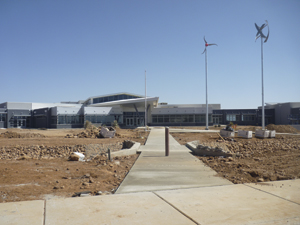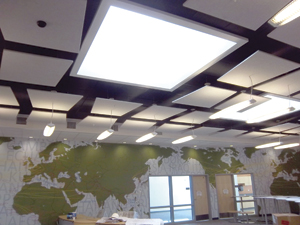BY DAVID M. BROWN
When schools open for the fall 2012 semester, this school will be at the top of the class.
On June 15, the Arizona office of Turner Construction Company obtained substantial completion of the $22 million Colonel Smith Middle School in Fort Huachuca, Arizona, about 90 miles southeast of Tucson, for the Fort Huachuca Accommodation School District. A dedication ceremony is being held Aug. 3 at the school.
The 88,700-square-foot project is expected to be the state’s first net zero school and the nation’s twelfth. Approximately 375 sixth- through eighth-grade students will benefit from its sustainable education facilities. Groundbreaking was May 5, 2011.
For net zero certification, a building must annually generate on site as much or more energy than it consumes. This means that if the school’s one-year energy bill shows that more energy has been created than expended, it is considered to have achieved net zero efficiency.
This Arizona school will preach what it practices.
Situated on 26 acres, the Colonel Smith Middle School will also be a living lab delivering a STEM curriculum: Science, Technology, Engineering and Mathematics. Sustainable components will be available to students through a dashboard which will monitor 37 energy-consuming points throughout the school. Students will have hand-held devices with an app for the energy dashboard and will be able to monitor the energy use and production in real time.
The innovative dashboard is an instructional component at the school, checking electrical usage, electricity produced through wind and solar, gas consumption, and water collected through rainwater harvesting.
“Each student will have an app on their handheld tablets, which mimic the dashboard, allowing them to monitor energy production and consumption in real time from any part of the campus,” explains Shawn Rosenberger, Turner’s vice president and general manager. He adds that using handhelds for this and other instructional purposes will lead the school toward a paperless space.
“The dashboard provides tremendous resources for project-based instruction and reinforces the importance of a sustainable environment to our students,” he notes. “In this way, they can see how they’re acting in terms of energy efficiency and how they and others in the building can adjust behaviors: What can I do to improve? And, this process and mindset can lead to healthy competition between classes and grade levels.”
The Colonel Smith Middle School is a significant building in many ways, explains Michael Deane, Turner vice president and chief sustainability officer. Turner has been ranked the #1 general and green contractor in the U.S. by Engineering News Record for the four years ending 2011.
“For one, the school creates a better learning environment by engaging the students and staff in a very active way such as using the building management systems as a learning tool for the students,” he adds. “We hope that it will be an exemplar of how to design a learning environment for the 21st century.”
The sustainable building teaches through a carefully chosen palette, from passive strategies through on-the-cusp technologies.
“The first and most important approach is using good traditional design to maximize the efficiency of the building envelope, be sensitive to site conditions [wind, light, thermal massing, solar orientation and others] before thinking about onsite renewable energy generation,” Deane says. “By reducing demand, you can reduce the cost and technology burden of providing power.”
“In this way, energy-efficient design ensured a high level of sustainability even before groundbreaking,” Rosenberger adds. “We were involved with the project team on conceptual design long before construction began on site.”
For example, the building is sited to maximize daylighting and minimize artificial lighting requirements. “Most spaces in the building will not require any artificial lighting during normal hours,” he explains.
Varying-height windows, including clerestory banks, will provide a layered introduction of natural light. The tinted low-E glass on the west, east, and south is screened and fitted with metal eyebrows. On the north, clear insulated glass maximizes natural lighting.
 In addition, energy-efficient skylights with prismatic lenses should fulfill 100 percent of the lumen requirements for their spaces. Daylighted spaces incorporate occupancy and lighting sensors that will only turn lights on when ambient light is below programmed levels and the area is occupied, and LED light is prevalent indoors and out.
In addition, energy-efficient skylights with prismatic lenses should fulfill 100 percent of the lumen requirements for their spaces. Daylighted spaces incorporate occupancy and lighting sensors that will only turn lights on when ambient light is below programmed levels and the area is occupied, and LED light is prevalent indoors and out.
“Throughout the building, we’ve placed a series of graphic eyes that allow lighting scenes to be preset for different times of day and night and varying uses,” Rosenberger explains.
A number of the strategies will be monitored by the students on their hand-helds. These include photovoltaic solar panels that can provide 100 percent of the building’s daytime electrical requirements. The domestic hot water system is heated using additional closed-loop roof-mounted solar collectors. These arrays should supply all domestic hot water requirements of the school – even in the winter, when chilly days are common in the high-elevation area.
Also watched will be the performance of three wind turbines – two horizontal and one vertical-axis – which add to the energy off the grid. “Because the area does not experience steady winds, the turbines are placed for demonstration and will allow students to compare the efficiency of different turbine designs,” Rosenberger says. “At the same time, they do provide an alternative energy source during stormy and night conditions when the solar arrays are not generating power.”
“We showcased them near the entrance to the campus, so you can’t miss them; they’re ‘in your face,’ so the children are reminded every day about even small items that can assist with energy reduction,” he adds.
Similarly, the design and construction team placed other sustainable components at ground level, such as most of the solar panels and HVAC units – unlike traditional rooftop hideaway procedures.
The students will also be able to check the water-harvesting system – two 25,000-gallon lined galvanized steel storage tanks, which collect runoff from the artificial turf football field and the building roofs for irrigation.
“A typical summer monsoon can recharge the tanks with a single storm, so, based on yearly rainfall averages, the tanks should be able to supply normal watering requirements without using any city supplies,” Rosenberger says, noting that Turner also created a channel through the site that controls storm run-off, which recharges the water table.
The construction team also reused materials: A road that traveled through the middle of the site had to be abandoned; the asphalt was removed, ground up and reused as a base for new parking lots. In addition, the school has a recycling program and a research center on the campus that will further instruct about conservation methods.
Other sustainable materials were used whenever possible: low-VOC Sherwin Williams paints; wall coverings made with RECORE Recycled Wall Technology with 30 percent recycled content; Interface recycled carpet tiles; and GREENGUARD-certified furniture.
The most important element, of course, is the overall experience children will encounter every day.
“Students are our most sustainable feature,” Rosenberger says. “By making sustainability not just part of the curriculum but daily life, the combined actual and subliminal lessons become a part of how they will act in school and beyond school. The idea is to live it – not just learn it.”





